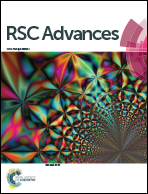Ideal rear contact formed via employing a conjugated polymer for Si/PEDOT:PSS hybrid solar cells†
Abstract
Recently, Si/organic polymer hybrid solar cells have been widely studied as the candidate for low-cost photovoltaics due to the simple low-temperature fabrication process. However, the rear electrode typically formed by directly depositing Al on the n-type Si is a Schottky contact, severely impacting the electron collecting efficiency. Here, an alcohol soluble polymer, poly[(9,9-bis(3′-(N,N-diethylamino)propyl)-2,7-fluorene)-alt-2,7-(9,9-dioctylfluorene)] (PFN), is firstly introduced to the Al/n-Si interface to improve the contact property, resulting in a remarkable reduced work function of the Al electrode and thus a good ohmic contact. An excellent photovoltaic efficiency of 13.35% is achieved in a planar device with a PFN layer. The facilitated electron collection efficiency associated with the ohmic contact not only improves the fill factor, but also enhances the short circuit current. Furthermore, the open circuit voltage increases significantly mainly due to the constructive effect of the built-in electric field of the rear contact on the total built-in electric field of the solar cell. Dark current–voltage, capacitance–voltage and electrochemical impedance spectra are used to systemically investigate the influence of the PFN layer on the performance, with prospects of receiving a high efficiency device with the quality rear contact.


 Please wait while we load your content...
Please wait while we load your content...